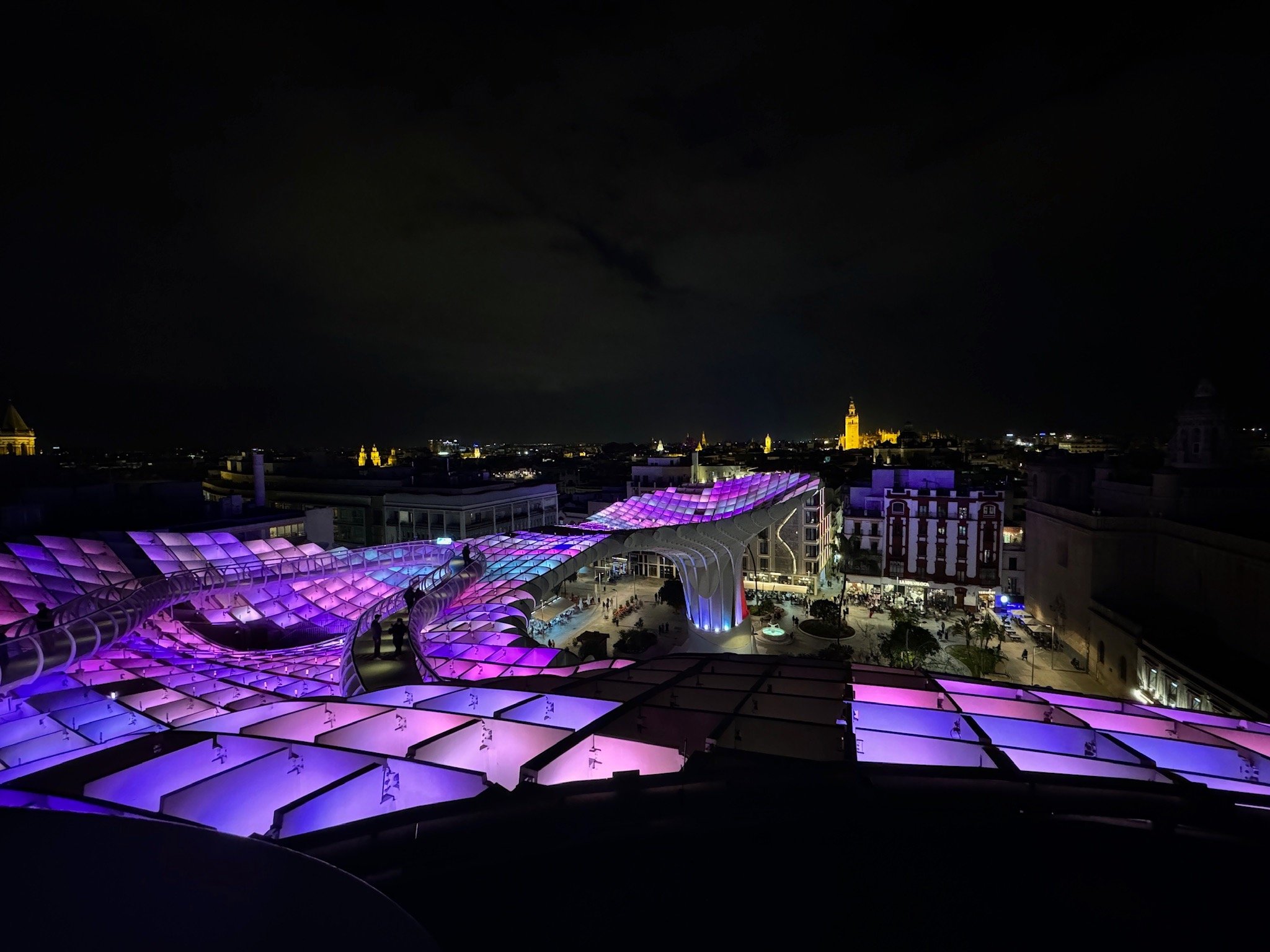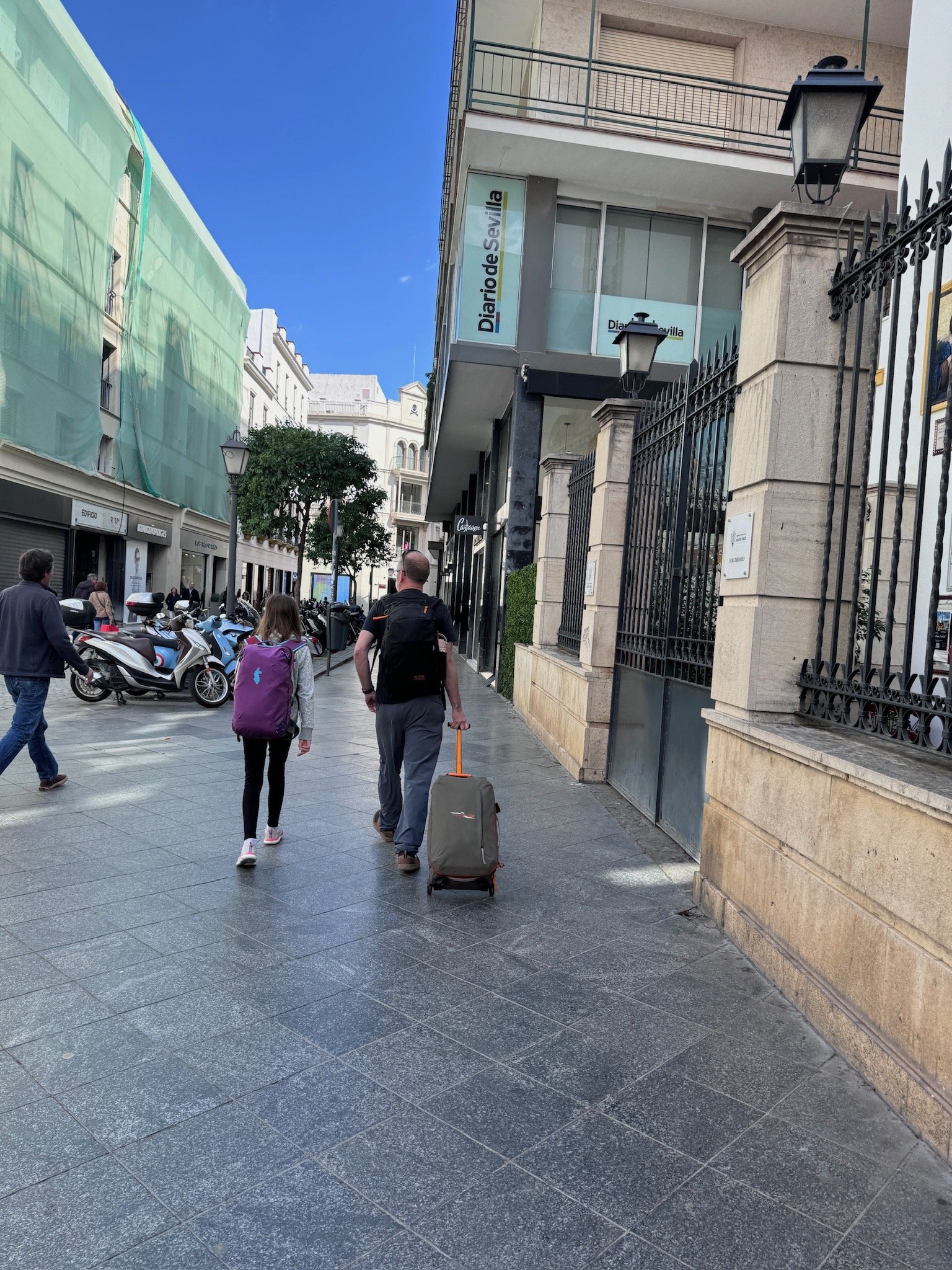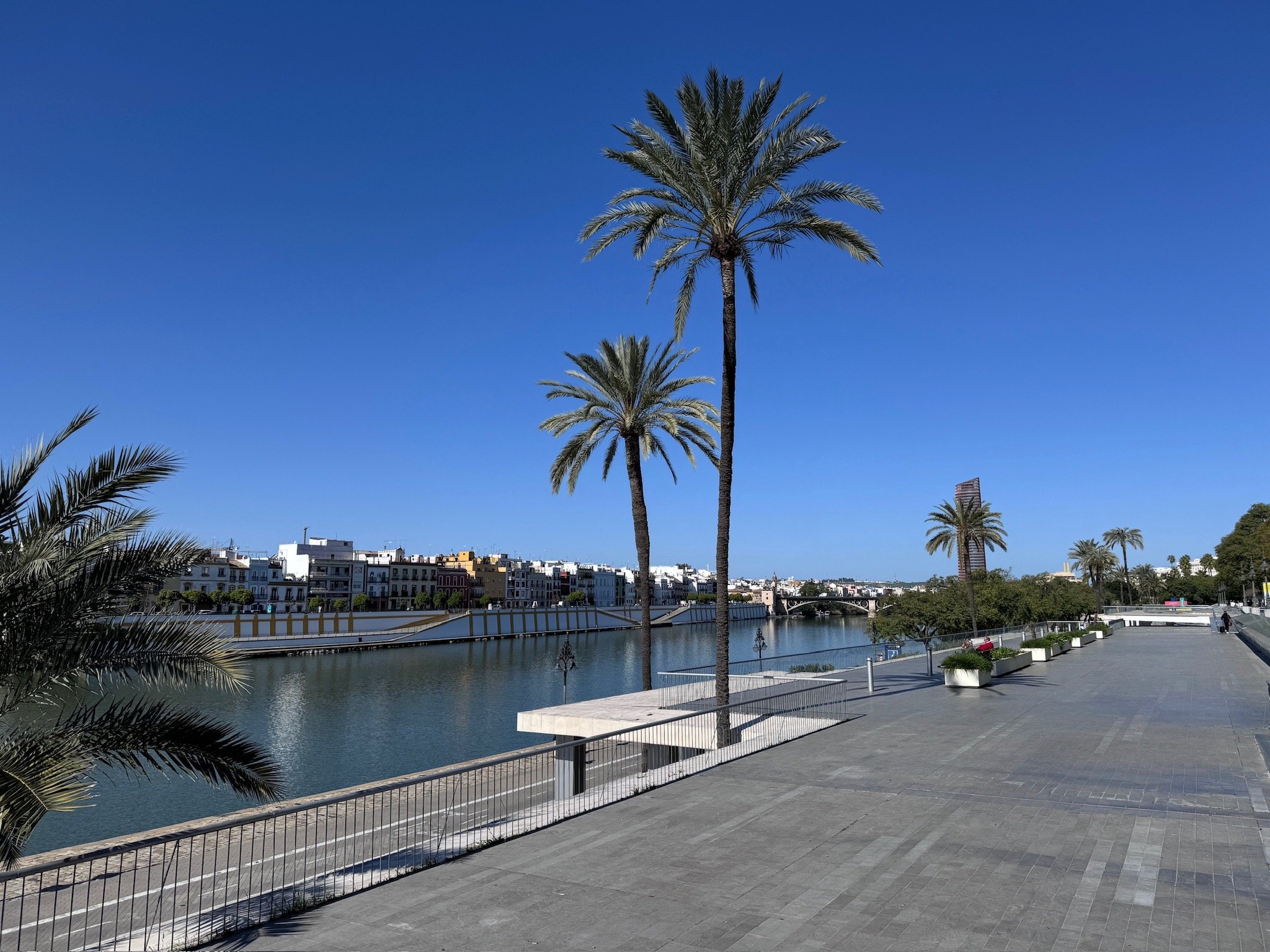Seville, Spain - Day 4

Sunday, March 3, 2024
Today we spent another day in Seville, Spain. We enjoyed a slower start to our morning, letting the kids sleep in late. I blogged, and Andi did some trip planning from the comforts of our airbnb.
Around 11:00am, the four of us ventured out to explore the city. Andi wanted to spend some time in the Triana neighborhood today. This area has a long history of bull fighting and flamenco dancers, but there’s also a mercado there with food stalls and lots of cafes and restaurants lining Betis Street. I love what a walkable city Seville is; navigating our way through the narrow, cobblestone streets is half the fun as we take in the beautiful architecture of the buildings, the people, and the plazas.
Andi picked to eat at Mercado Lonja del Barranco for lunch — one of the many food markets in Seville. Mercado Lonja is different than the Triana Market we visited the other day in that it is more of a food hall, and less a market that sells vegetables, wine, produce, and fish. We arrived to Mercado Lonja del Barranco right around Noon, just as the food hall was opening. There weren’t a lot of customers yet which gave us the opportunity to look around and see what we wanted to eat. The market filled in quickly though, so I’m glad we arrived when we did.
Mercado Lonja is the type of place where you order what you want from different food counters, so Andi took care of getting food for us while I ordered Tory and Aden’s meals from another stand. I like food halls like this because everyone gets what they want to eat. Right away, Aden settled on a hamburger and fries. Tory said she wasn’t very hungry, so she only wanted a meatball slider for her lunch. Andi picked a vendor selling different toasts and antipasto skewers. The Spanish love their toasts; they call them tostadas. I got a tuna toast, and Andi picked chicken with roquefort cheese, plus a toast topped with two artichoke hearts to share. Andi also got two antipasta skewers as well.
I loved my tuna tostada; it might be one of the best things I’ve eaten in Spain thus far. The open-faced slice of bread was firm to hold the toppings, but soft enough to eat. One bite of an antipasto skewer made Andi’s stomach lurch though. He slid his plate over to me, and said he couldn’t finish the meal. Instead, he went to a counter and ordered a small bowl of shrimp paella, which was mostly rice. It wasn’t that the antipasto skewers were bad at all, but that Andi’s stomach is still very sensitive to what he eats. He’s been trying hard to stick to grilled chicken or fish, boiled vegetables, rice, soup; things that are relatively bland and easy to digest, but it’s been really hard to find those kinds of foods all the time while we’re traveling. If he eats something that doesn’t agree with his stomach, he immediately knows it, and usually pays the price with stomach cramping for the rest of the day.
The patio outside the food hall was packed with people enjoying their lunches in the sunshine. It was a beautiful day in Seville with temperatures in the mid-60’s. Andi and I both commented what a drinking culture it is in Spain. Drinks with lunch are the norm.
We finished our meals, and then walked across the Triana Bridge to officially enter the neighborhood. On a sunny Sunday afternoon, there were people everywhere enjoying food and drinks on restaurant patios. The four of us walked around for a while before deciding to take a cab to the science museum in Seville.
Andi didn’t sleep well last night, and had already been experiencing some stomach cramping this morning. Eating lunch only made the cramping worse. Usually he does a really good job of hiding his discomfort, but this afternoon I could tell Andi’s stomach was really bothering him. I suggested we go back to our airbnb, but he said he could push through the cramps — he just wanted to find a place to sit down somewhere. So, to Casa de la Ciencia museum we went.
Ten minutes later, the taxi dropped us off on the steps of the science museum. We paid our admission, which surprisingly wasn’t very expensive — €3 per person. Then, the four of us spent the next 90 minutes walking around the museum. This science museum wasn’t nearly as kid-friendly as the one in Lagos, Portugal had been. Even I was having a hard time understanding the science behind the exhibits. The signage wasn’t in English, so I had to use my Google Translate app to assist us in learning. I think Tory and Aden still enjoyed themselves, though. They especially liked the exhibit with virtual headsets.
After the science museum, we walked across the street to the famous Plaza de Espana inside María Luisa Park. What a gorgeous area of Seville this is! It reminded me of Central Park in New York with horse-drawn carriage rides, food cart vendors selling popcorn and cotton candy, and numerous people strolling around, or lying in the grass enjoying a sunny Sunday afternoon.
The Plaza de Espana building is semi-circle shaped and pays homage to different areas of Spain. Impressive hand-painted tiles, marble, bricks, and a fountain in its center make the plaza look regal.
We spent about an hour wandering in and around María Luisa Park before slowly making our way back to our airbnb on foot. Andi’s stomach cramps had subsided, but now he said he needed to find something to eat. We stopped at a tapas restaurant along the way and ordered several small plates to share — grilled shrimp, chicken bites and fries, beef cheeks (which tasted similar to roast), potato salad, and fried goat cheese drizzled with honey. I could’ve sat at that outdoor table and people-watched for hours. It was so fun to observe all the people walking. One thing we’ve noticed is how family friendly the city of Seville is — there were loads of families walking by our table, and many people pushing strollers. Nobody seems bothered by having kids around.
Tonight, we planned to visit Metropol Parasol, or Las Setas, as it’s commonly referred to in the city because the wood structure looks like a cluster of mushrooms. Since we ate a late afternoon snack around 4:00pm, none of us were hungry for dinner. We waited for it to get dark outside, and then we walked to the Metropol Parasol which is just minutes away from our airbnb. This is a community space day and night, as it houses a food & retail market on the first floor, a green space on a middle level, and a mirador viewing deck on the top floor. We’d heard it’s best to go to the top at night to see the city lit up, so that’s what we did.
I thought tickets to the top were kind of expensive (€45 for a family of four), but Tory and Aden were really excited about it. We paid for our tickets and then rode the elevator up to the top floor. It was really neat to see Seville’s city lights at night, as well as the changing colors of Las Sedas. Visitors can take as much time as they like wandering around the top viewpoints.
How’s the view, Tory? The downside of being short & being eye-level with the guardrail.
There’s also a video about the city of Seville which plays inside a top-floor theatre every 30 minutes. Tory said she knew it was going to be an interactive show when the announcer said we’d “feel” Seville with all our senses. During the short movie about the city, there were smells piped through the theatre, fans blowing to simulate wind, and lots of lighting effects. At times, I couldn’t tell if the room was spinning, or if it was the screen moving!
All four of us really enjoyed visiting Las Setas. Afterwards, we made the five-minute walk back to our airbnb. On a Sunday evening, the streets were eerily quiet with most businesses closed and people at home for the night.
Tomorrow, we have one more day in Seville. We’re planning to see the inside of the cathedral, and I’m looking forward to that.






















